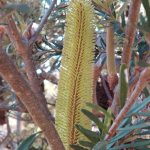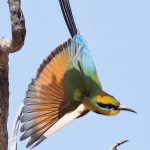If you’re anything like me, you’ll look for every opportunity to explore the outdoors. So what have you noticed most about this summer? It’s been cooler and wetter for sure. I can’t remember the last time there was still green in the hay paddocks in February!
But what stood out most to me as I ambled through the forests and conservation parks of the Adelaide Hills and Barossa, was the abundance of the ‘three B’s’. Banksias, bursarias and (Rainbow) bee-eaters.
In South Australia, there are two types of Banksia. Our local species is the Silver Banksia or Banksia marginata. This tree is distinctive, with bright conical yellow flowers and was once abundant throughout our region. Sadly, over recent years, most banksias I have seen have been dead or dying. Of more concern is how few have been seeding.
These vital nectar-rich trees are highly susceptible to Phytophthora – particularly in our higher rainfall areas.
Over the last couple of years, I became quite despondent about the survival rates. But this summer has kindled sparks of joy in my little nature-loving heart.
This summer, they are fighting back. From Kaiserstuhl, through Hale across Mount Crawford then down through Cromer, the banksias are blooming. And even better, the juveniles are looking incredibly healthy too!
So how can we help them? By being mindful of where we tread, keeping our boots clean and Phytophthora free.
And what about the Bursaria spinosa – or Christmas Bush as we call it? No matter where I’ve been in SA this year, through forests and bushland, in paddocks, and along verges, this stunning plant has put on an amazing display! Crowns of snowy white flowers have been everywhere.
The flowers are fragrant, and its densely packed branches provide a haven for our smaller birds, butterflies (how many of those are about this year?) and other insects.
This summer, I am sure, has been their best year yet.
On the bird front, this summer has been notable for the stunning little Rainbow Bee-eaters. These pretty, medium-sized birds are found throughout Australia, however, the southern flocks migrate north in the cooler months.
Upon their return, they settle to nest in forests, open woodland, and in banks, mines and quarries as long as there is water nearby.
Did you know that these little insectivores don’t live in trees? They dig tunnels almost 90 cm long into sandy banks and then build a nesting chamber at the end, lined with grasses for comfort.
They’re quite a community-minded bird and whilst both parents incubate the eggs and feed the young, others in the flock will also assist.
November to January is the breeding season in southern Australia, so if you want to spot these beautiful and unique little birds, grab your binoculars and settle down near river banks. The emergence of fledglings from the hollow taking their first flight is a sight to behold.
Hope to see you next year on the tracks!
- Silver Banksia flower
- Juvenile Silver Banksia flower
- Christmas bush (Bursaria spinosa)
- Bursaria spinosa flower
- Rainbow bee-eater
- Rainbow bee-eater in flight
- A row of Banksia marginata flowers at different life stages













Leave A Comment